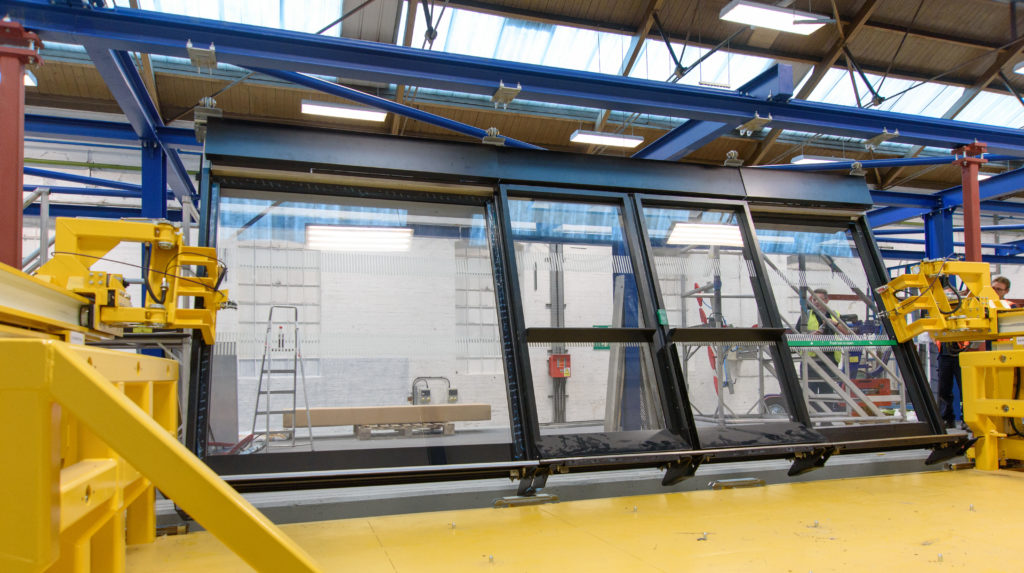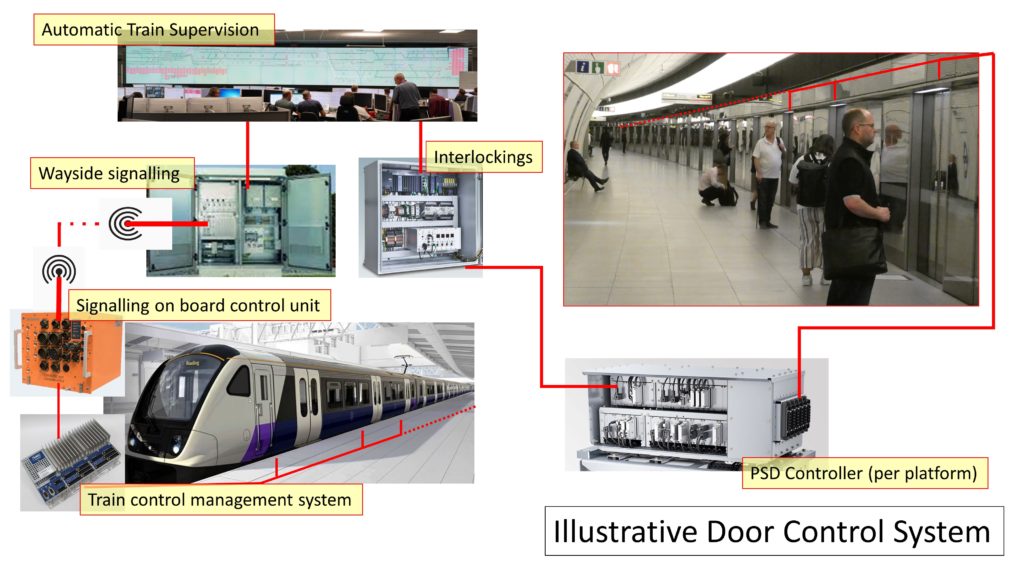Much has been written about the engineering marvel that is the Elizabeth line, which opened on 24 May 2022. There have been many articles, conferences, and TV documentaries chronicling its construction, and a two-part programme on BBC 2 in June focused on systems integration. This is something that is usually not visible, but the implications of not integrating properly is a railway that doesn’t work. When chairman of British Railways in the 1980s, the late Sir Peter Parker observed that railways tend to fall flat on their interfaces. With the advent of computers and telecoms systems, that has never been truer.
Take the Elizabeth line’s Platform Screen Doors (PSDs) which were specified for its eight underground stations. This amounts to 432 pairs of doors which seems a lot, although compared with the 3,780 pairs of sliding plug doors on the trains it is quite a modest number. However, each PSD represents a potential single point failure. We’ll come back to this.
The casual reader might assume that the Elizabeth line’s PSDs would be just another version of those fitted to the Jubilee line which, coincidentally, also has eight underground stations so equipped, albeit with 476 door pairs. But the environment on the Elizabeth line is quite different. Three significant differences are that: i) compared with the Jubilee line, the Elizabeth line screens are floor to ceiling, so the latter have to withstand pressure pulses not present on the former; ii) Elizabeth line systems have to provide access for maintenance whilst protecting the maintainer from the 25 kV overhead rail; and iii) Elizabeth line systems enable a selective door function, that allows for PSDs not to open if the adjacent train door is locked and vice-versa. Both lines’ platform door systems were manufactured and installed by Knorr-Bremse Rail Systems (UK) Ltd, and Knorr-Bremse Group’s IFE division manufactured and supplied the class 345 train door systems.


The original concept for Crossrail was 10-car trains of 20-metre-long cars. In the end, Bombardier won the contract with 9-car trains of just under 23 metre-long cars. Clearly, this matters for the PSD design as the train and platform doors must align perfectly, leading to the original PSD design concept being amended. PSD design has evolved and become quite standardised since they were first adopted on the Singapore metro in the late 1980s. Clearly, heights/widths and spacings must be decided and site-specific issues such as wind loadings must be agreed. Then, thoughts turned to authorisation for use.
Compliance and authorisation
The Elizabeth line was subject to the Interoperability Requirements of the Railways and other transport systems regulations, as well as the common safety method (CSM) on risk evaluation and assessment. As far as your writer is aware, this was the first time PSDs had to be authorised under these regulations. The Technical Specifications for Interoperability were silent on PSDs. For demonstration that risks had been properly evaluated and assessed, the choices were demonstrating compliance with Codes of Practice (e.g., Euronorms), comparing against Reference Systems, or carrying out Explicit Risk Estimation (a.k.a., QRA).
At the time there were no codes of practice or relevant reference systems, and explicit risk estimation is an exhaustive and exhausting process. It was hoped that an international committee would develop a Euronorm in time. In the event, it was not until 2021 that Euronorm EN17168 ‘Railway applications. Platform barrier systems’ was published so, apart from some sub-systems which were already approved, much explicit risk estimation was undertaken.
Challenging installation
It was not feasible to transport the pre-glazed door and screen modules from surface to platform as the logistics for the deep stations would have been impossible. Instead, base plates on the platforms were carefully installed in exactly the right places, and the pre-built modules were delivered on works trains which were equipped with special manipulators to slide the modules precisely onto the baseplates once the train has been positioned approximately in the right place longitudinally.
Not only did these manipulators have to move the door modules horizontally and longitudinally, they also had to be able to be tilted to clear pre-installed vertical and horizontal beams. Once the doors and screens were in place, other disciplines filled the space between the top of the door modules and the tunnel roof including other services such as lighting and passenger information screens.

wagons. PHOTO: KNORR BREMSE

information screens. PHOTO: FRANK FOLEY
Frank Foley, lead PSD engineer for Crossrail at the time said: “The design, installation, testing and integration of the Elizabeth line Platform Screen Doors has been a great challenge – much more so than is obvious for a system that ‘just opens and closes the doors’. Practical and logistical constraints around physical access, coordination and safety on site have on occasion caused excitement; technical and integration issues have taken many people and many hours of testing, careful analysis, consultation, innovation and collaboration between teams.”
A good place to admire the installation is on the eastbound platform at Tottenham Court Road where the flat glass doors and screens follow the gentle curve – the only curved platform on the new build sections of the Elizabeth line.
System controls
Clearly the PSDs must be perfectly synchronised with the train doors. This involves interfaces with the signalling system, the SCADA system, and, of course, the power supply. Station staff and control room staff need to know about any failures.
If a PSD on the Jubilee line fails it can be locked closed, and the service continues even though the train door adjacent to the failed will open and close as usual. There is no equivalent on the trains; if a train door fails, then the train is taken out of service.
On the Elizabeth line there is a new feature that makes the control system more sophisticated. Firstly, as is usual main line practice, individual train doors can be locked out of use, and this information is reported to the train’s control system – TCMS. Each PSD can be locked out of use too and its status is reported back to the PSD controller. In normal operation, the train brakes to a stand automatically. When the signalling system registers that it has stopped in the correct position, it issues permission for the doors on the correct side of the train to be released.

When the ATO or the train driver signals to open the doors, the train’s TCMS issues an instruction to open the train doors and, simultaneously, a signal goes from the TCMS to the Siemens Trainguard MT On Board Control Unit (OBCU) which is transmitted to the wayside signalling system and on to the correct station PSD controller which instructs the PSDs to open. It takes longer to write about this than for the instruction to be carried out, as the train and platform doors open or close more or less in sync.
The additional feature is that locked-out train or platform doors are synchronised with the adjacent door; be it train or platform. If a train door is locked out, during the transit from one station to the next, the TCMS via the OBCU, and wayside signalling, sends this information to the next station’s PSD controller so that the PSD adjacent to the locked-out train door remains closed. as illustrated in the photo on page 64. So far, so good. This is a useful system but no substitute for reliability as locked-out doors tend to increase dwell times.

There is also, currently an integration issue in the overall PSD-Signalling-Train system when there are two trains in transit between stations at the same time, something that will happen frequently when the service ramps up to 24 trains per hour. The following illustrates the issue:
If the first train has some defective doors, the TCMS, via the signalling system, tells PSDs and the appropriate PSDs stay closed. This is still held in PSD system memory and when the second train is approaching, the PSD controller, again via the signalling system, tells the second train’s TCMS that some PSDs are isolated. This TCMS then inhibits the corresponding train doors. The trouble is that the second train’s TCMS has got in first and told the PSD controller that all the train doors are healthy. This means that when the second train stops, all the PSDs open but the inhibited train doors stay closed. This is termed the ‘door inhibit carry-over’ issue and, fortunately, the remedy is a straightforward change to the software within the overall PSD-Signalling-Train system.
Another feature of the system is that this process only works once the failure has been identified and the appropriate door has been locked out of use. Where it doesn’t work is if the PSD fails to a) open or b) close properly. In the case of a), the train door will still open and, in the case of b), the train cannot depart until someone has attended, encouraged the PSD to close, and has locked it out of use.
Solution in the data
The systems integration team working on Crossrail, from consultants WSP and CPC systems, has been working on a data to information system for the PSDs. By design, PSD controllers and the SCADA system collect closing times and interlock alarms for all 27 PSDs on each platform face and this can be aggregated across the whole suite of 432 door pairs. Luke Church and Alex Barber from CPC Systems built an application that analyses this data, which is currently nearly 77,000 open/close cycles per day but will more than double when 24 trains per hour services are introduced and Bond Street station opens.

Alex Barber said “the data set required to monitor the PSDs was already present in existing signalling logs. The challenge was in shaping the data into useful information then making that insight integral to maintenance operations.” The software looks for trends. SCADA provides individual door alarms, but using lower-level trending of close times, the whole platform interlock signal is used. This always gives the slowest door to close but, at that stage, which of the 27 might not be known. If one close cycle is particularly bad (for example, if there is extra pressure in the tunnel from a nearby train) then SCADA alarms will highlight that door.
Having identified doors that might be getting to the edge of tolerance for reliable operation, the software alerts the issue to Knorr-Bremse and then maintainers are deployed to visit, and feedback what they find so that the software algorithms may be improved. Already some service-affecting failures have been prevented. As the software is optimised, one day the system might automatically issue work orders.
Frank Foley concluded: “There will always be things that could have been done better or could be improved in retrospect. But all the teams and individuals involved in delivering the system can be truly proud of their contribution. We hope that our friends and colleagues now operating and maintaining the system are as proud of it as we are.”

Stuart Mills, director of infrastructure for the Elizabeth line, who in a former role was responsible for the Jubilee line PSDs, is very pleased.
Imagine this type of analysis for the 3780 sliding plug doors on the class 345 trains, a big opportunity!
Thanks to Frank Foley formerly of Crossrail, and colleagues in CPC Systems for their assistance in producing this article.

